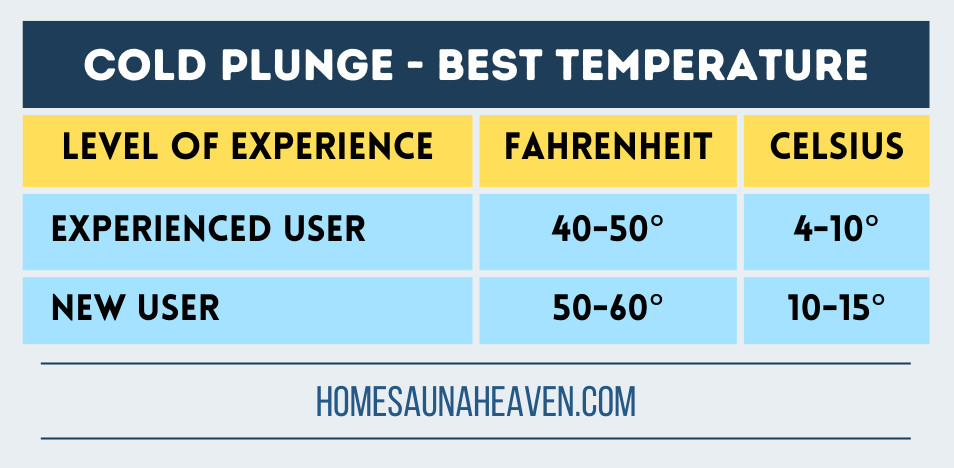
The best temperature for a cold plunge is between 40 to 60 degrees Fahrenheit. This works out at 4 to 15 degrees Celsius. Experienced Users tend to aim for the 40 to 50 degrees Fahrenheit range while New Users do better starting with a temperature of between 50 to 60 degrees Fahrenheit. Below we cover everything you need to know about the best cold plunge temperature and how to achieve it.
Understanding Cold Plunge Temperature
If you want to get the most from your cold plunge experience aim for a temperature of between between 40 to 60 degrees Fahrenheit. This is the sweet spot for getting the most from all the health benefits you can expect from plunging your body into a pool of cold water and shocking the system.

Note, the precise optimal temperature for a cold water plunge varies based on individual preferences, health considerations, and the specific benefits you’re seeking. For example, experienced users are comfortable with lower temperatures while beginners should start with a warmer temperature and work their way down slowly if they feel comfortable doing so.
The invigorating sensation of immersing in a cold plunge is usually enjoyed in tandem with heat therapy. Most users like to spend some time in a sauna, steam room, or hot tub before briefly submerging in cold water and jolting the system. But, to get the most from a cold water bath – you need to adjust it to the best temperature.
Beginners
The best temperature for a cold plunge for beginners is 50 to 60 degrees Fahrenheit, or 10 to 15 degrees Celsius. Evidence shows that this temperature works well for relieving muscle soreness, enhancing circulation, and boosting the immune system. This is also a milder range and not quite as cold as the recommended temperatures for an experienced user.

Beginners should start with a milder temperature and allow time for their body to adjust to the experience of plunging in cold water. Going too cold, too soon can have negative consequences – see the safety concerns below. And, for these reasons a temperature of 50-60°F works best.
Experienced Users
Experienced users have built up a tolerance to the chilling effects of cold water. And, these users should aim for a cold water plunge temperature of 40 to 50 degrees Fahrenheit. This works out at 4 to 10 degrees Celsius. Very chilly.

These temperatures can feel exceptionally cold to the uninitiated and should only be used by individuals who are used to jumping in the cold water. The battle-hardened cold plungers! It takes time to reach these cold temperatures.
Over time, repeated exposure to water in this temperature range can lead to physiological changes that enhance the body’s ability to withstand and recover from the cold icy water. The sudden immersion in an ice bath triggers a rush of endorphins and heightens the senses making us feel more awake and alert.
READ NEXT
What About Cold Plunge Temperature for Sauna?

Sauna and cold water plunging go hand in hand. Whether it’s jumping in a lake next to an outdoor sauna in the wilderness or climbing into a cold water bath in your local spa – the contrast of intense heat and icy cold is a joy to so many of us.
But, what’s the best temperature for a cold plunge when you’re using a sauna? To get the most from your sauna cold water plunge routine, you need to choose the best cloud plunge temperature. And, when used with a sauna, this is 50 to 60 degrees Fahrenheit.
The water doesn’t have to be so cold when transitioning from sauna to a cold bath – as body temperature will be elevated from the time spent in the intense heat. A cold water temperature of anywhere between 50-60°F is ideal for use with a sauna.
Safety Considerations – What Happens If the Water Is Too Cold?
Just like any other activity, cold plunging comes with several potential dangers you need to be aware of. And, practicing some basic safety tips will ensure you have a pleasant and positive experience.

Choose the Right Temperature
First up, you should plunge in cold water that is at a temperature you feel manageable and manageable. Don’t jump into a cold water bath that is cold beyond your comfort zone. If you’re a beginner aim for the 50 to 60°F region.
Cold Shock
Cold shock is a nasty condition that can kick in when the body is suddenly exposed to very low temperatures. It triggers a range of involuntary reactions designed to protect the body.
The most common symptoms are a feeling of panic, gasping for breath, elevated heart rate, and increased blood pressure. These reactions are part of the body’s natural survival mechanisms and usually last 1-3 minutes. It can be very dangerous.
Physical Incapacitation
One of the most serious dangers of cold water immersion is the loss of muscular control. The condition can deteriorate the longer the individual remains in the water. Inexperienced plungers should avoid water that is too cold and limit your session to as brief a period as possible.
Hypothermia
Hypothermia is another significant danger of cold water plunging. It occurs when the body loses heat faster than it can produce it. To avoid experiencing hypothermia limit your dip to a brief period of time and choose water that is not too cold for your body.
Underlying Health Conditions
If you have any underlying health conditions you should consult a medical professional for advice before practicing cold water plunging. You should consider your individual health condition before deciding to jump in at the deep end.
How Long Should You Stay in a Cold Plunge?
In general, you should aim for an immersion time of 1-3 minutes in the cold water. This is long enough to experience all the benefits of cold water plunging without placing unnecessary strain on the body. However, newbies should spend just 10-30 seconds until their bodies build up a tolerance to the effects of cold water. For more see our full guide on How Long Should You Cold Plunge?
Cold Water Plunge Temperature FAQ
Can a Cold Plunge Be Too Cold?
Yes, a cold plunge can be too cold. You should not expose your body to low temperatures it cannot safely handle. If you are new to cold plunging you should aim for a cold water temperature of 60°F and gradually work your way down if you feel comfortable doing so.
Are Cold Plunges Good For Your Health?
Yes, cold plunges are good for your health. It is believed they are good for mental health, can reduce inflammation, speed up muscle recovery, and boost immune performance. For more check out our full guide to Is Cold Plunge Good For You?
Is a 1 minute Cold Plunge Good?
Yes, a 1 minute cold water plunge is good. This is long enough for your body to experience the rejuvenating and invigorating effects of the cold water. More experienced users often remain in the cold water for 3-5 minutes.
READ NEXT
- Cold Water Plunge Safety Tips
- Outdoor Sauna & Cold Plunge
- How Often Should You Cold Plunge?
- What’s Better: Cold Plunge or Cold Shower?
About the Author
JAKE RAOUL
• Sauna Specialist
Meet Jake, a man with a passion for sauna therapy. Jake’s background is in science. And, his passion is wellness and basketball. Growing up in Orlando Florida, Jake enrolled in Florida International University where he graduated with a BS in Biological Sciences.
As a young man, he worked in the spa and wellness center at the renowned Breakers Palm Beach luxury hotel. Here he developed his skills and understanding of client-centered wellness delivery. Upon graduating from FIU he took up a research position focusing on the application and practical effects of steam therapy.
His research has contributed to advancing the understanding of steam sauna therapy and how it can be applied in the occupational health environment. His work in this area has been officially recognized for its impact on the field.
Jake is a devoted fan of the Orlando Magic basketball team. When not working and advancing his research he enjoys attending games at the Kia Center in downtown Orlando. He also likes to remain active in his local sports community and volunteers as a basketball coach for his local youth team.
With his background in scientific research and passion for wellness, Jake is a valuable addition to the Home Sauna Heaven writer’s team where he shares his knowledge and understanding of sauna therapy, steam sauna therapy, and how they can be used for best effect.
